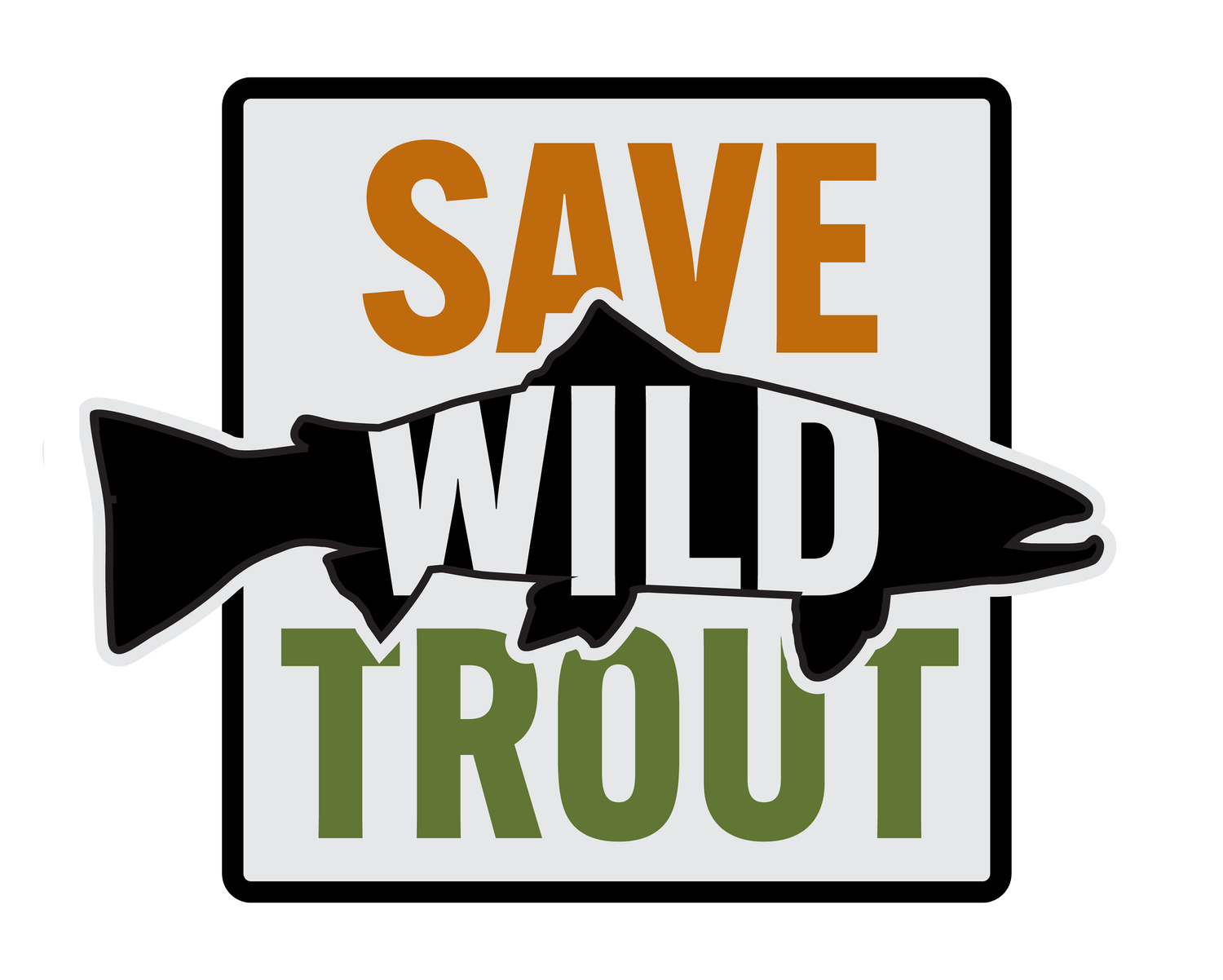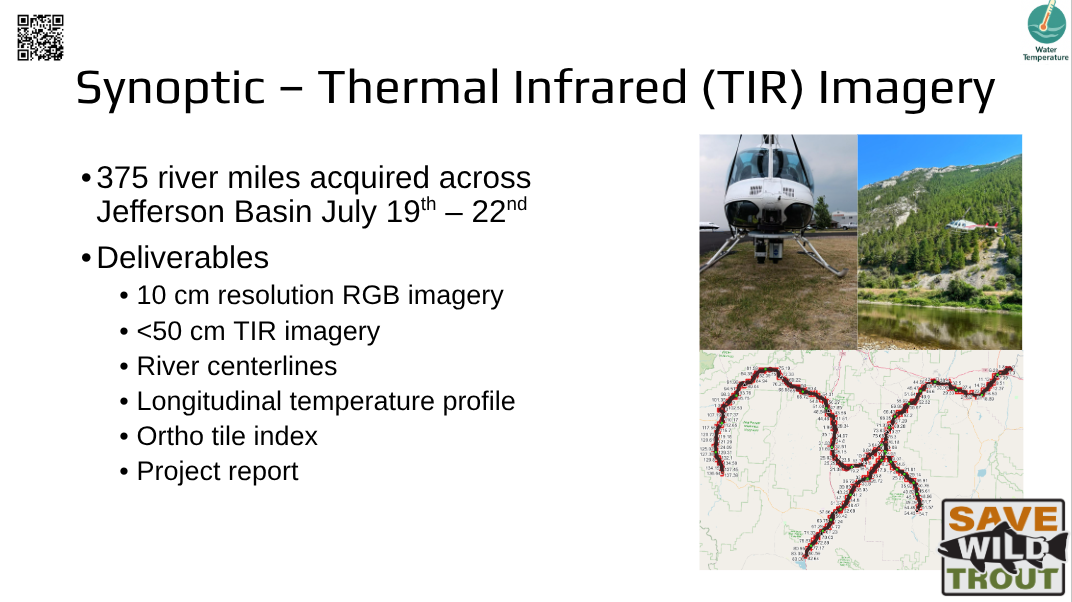FAQ: Save Wild Trout Abiotic FY23/24 Report
Who is Save Wild Trout?
Save Wild Trout is a science-driven campaign dedicated to protecting and restoring the last, best cold-water fisheries in southwest Montana. Born out of concern over the dramatic collapse of wild trout populations in the Jefferson River Basin, the campaign brings together scientists, anglers, advocates, and community members to identify root causes of fishery decline and drive meaningful solutions.
Through rigorous monitoring, public education, and advocacy, Save Wild Trout works to ensure that Montana’s iconic wild trout rivers—like the Big Hole, Beaverhead, Ruby, and Jefferson—remain healthy, resilient, and thriving for future generations.
What did Save Wild Trout study?
Save Wild Trout performed a first-of-its-kind investigation of core water quality parameters related to wild trout health across southwest Montana's Jefferson River Basin. Led by Dr. Kyle Flynn of KF2 Consulting, the study was first launched in late summer 2023 to evaluate a snapshot of water quality conditions in keynote blue ribbon fisheries after a tough, hot, summer and multiple reports of severe algal blooms, hot river temperatures, and poor fishery recruitment numbers by natural resource agencies.
Slide from presentation on July 14, 2025.
The campaign specifically examined, through in-situ sondes and mechanical devices that measured real-time data, the water quality parameters of temperature and dissolved oxygen, as both have a direct and undisputed effect on aquatic life, including habitat quality, recruitment, and mortality causes.
The campaign also retained the services of NV5, a geospatial firm, to perform a first-of-its-kind aerial Forward Looking Infrared and Radar (FLIR) survey of the mainstem Big Hole, Beaverhead, Ruby, and Jefferson Rivers. This aerial survey confirmed site-specific monitoring and visually displayed where, from a temperature perspective, some of the worst and best river conditions exist, providing critical data for years to come to prioritize effective, targeted restoration projects.
Where did Save Wild Trout investigate?
Based on the snapshot of river health developed in late summer 2023, Save Wild Trout launched a basin-scale abiotic study of dissolved oxygen and river temperatures across the ~9,000 sq miles of southwest Montana's Jefferson River Basin. This basin has historically hosted some of Montana's best wild trout fisheries and includes the Big Hole, Beaverhead, Jefferson and Ruby rivers.
Why is Save Wild Trout focused on SW Montana's Jefferson River Basin?
Reporting from the Montana Fish, Wildlife and Parks biologists in spring 2023 confirmed that wild trout populations in the Jefferson River Basin have crashed to historic lows, and initial sampling reported little to no recruitment; the statistically significant decline in fish counts per river combined with limited recruitment meant a big red warning light was flashing for anyone watching.
Southwest Montana’s rivers represent some of the last intact ecosystems that provide critical habitat for both terrestrial and aquatic species, including cold-water megafauna like wild trout. As a predominantly rural region, the loss of these fisheries would carry severe social and economic consequences.
Cold-water fisheries are not just ecologically important—they are central to Montana’s outdoor heritage and western way of life. The state is a world-class destination precisely because of its wild trout streams and iconic rivers. Montana’s outdoor economy generates approximately $7 billion in annual economic activity and supports over 70,000 jobs. In Beaverhead County—one of the state’s most rural and expansive counties—fly fishing, hunting, and other outdoor activities contribute more than $167 million annually and support over 1,400 jobs.
Put simply, the dramatic collapse of SW Montana's wild trout fisheries is our canary-in-the-coal-mine moment.
Save Wild Trout was created to identify key causes behind this region's population collapse, to think outside-the-box for solutions, and to ensure we build public and private consensus that our decision-makers implement solutions critical to restoring and protecting SW Montana's cold-water fisheries.
What are the core findings of Save Wild Trout's FY23/24 river sampling?
Slide from presentation on July 14, 2025.
Across the Jefferson River Basin, ambient water temperature and dissolved oxygen levels are at unnatural and unhealthy levels, including levels proven harmful to aquatic life. Significant concerns have been identified regarding thermal conditions and oxygen deficiencies in the Jefferson River Basin, which are unfavorable to salmonids and do not meet state water quality standards.
Similarly, regular field maintenance and visual surveys documented an abundance of nuisance algal growth. Eutrophication, which is the process where waterbodies become excessively enriched with nutrients, primarily nitrogen and phosphorus, leads to nuisance algal blooms and oxygen depletion. 2023 and 2024 sampling has confirmed statistically significant and abnormal temperatures and low dissolved oxygen, which in turn has confirmed the need to holistically evaluate nutrient pollution given the causal relationship between eutrophication - which is the overabundance of nutrients stimulating excessive growth of algae and aquatic plants - and the ecological effect of oxygen depletion in the water column.
Is this data verified and defensible?
Yes. Dr. Flynn applied protocols proven capable of defensible data that is both representative and accurate, and used by the Montana Department of Environmental Quality and the Environmental Protection Agency. Dr. Kyle Flynn in a renowned scientist with extensive experience in his field.
What are the likely pollution sources that cause or contribute to dissolved oxygen and temperature problems in freshwater rivers?
Low dissolved oxygen concentrations in freshwater is often linked to nutrient pollution and eutrophication. Excessive nutrient pollution feeds algae, and in combination with environmental factors, causes unnatural algal blooms that block sunlight in waterbodies. Aquatic life dies without sunlight. And even when alive, algal blooms and nuisance aquatic vegetation create daily swings in dissolved oxygen, supersaturating and conversely, depleting oxygen in a waterbody. These large swings are harmful to aquatic life. Likewise, eventually, the algal blooms die, and bacteria digest the algae and plants, using up remaining oxygen and giving off carbon dioxide. If aquatic life cannot swim away, fish and other wildlife become unhealthy or die due to a lack of oxygen. Similarly, vast mats of nuisance aquatic vegetation and algae increase water temperatures by absorbing radiation and warming water bodies, which in turn affect natural trophic regimes and macroinvertebrate communities.
Are plummeting dissolved oxygen levels and harmful water temperatures just a 'non point-source' problem?
Not necessarily. A wide variety of land use patterns are linked to water quality degradation, including causing and contributing to unnaturally warm water temperatures and low dissolved oxygen levels. In turn, federal law requires the permitting of a variety of point source activities, which refers to specific, discrete types of polluting activities, such as discharging wastes into a river through a pipe or backfilling wetlands.
Slide from presentation on July 14, 2025.
Conversely, state law provides authority to regulate a far broader swath of land use activities, including sectors not addressed by federal law. The issue of what's regulated or not often boils down to the yo-yo effect of state politics, where politicians make decisions to control certain sectors of land use, while exempting others, irrespective of science or proven best management practices.
Thus, for SW Montana's rivers, the starting point for any meaningful effort to protect the most sensitive uses of our waterways—our blue-ribbon fisheries—must begin with a scientific baseline of river health and a corollary focus on best strategies for improving resiliency to protect and restore those sensitive uses. We cannot protect what we cannot measure. Just like going to a doctor, as shown in Dr. Kyle Flynn’s July 14, 2025, presentation.
Who regulates river pollution in Montana?
The Montana Department of Environmental Quality has primary authority over all activities that can cause or contribute to negative water quality impacts.
Are dissolved oxygen and temperature pollution in Montana's rivers purely a low-flow problem?
No. The river management assumption in many western states has often been along the lines of "if there's water, it's healthy." The best available science, including Save Wild Trout's FY23/24 abiotic study, is proving that even when water is available, it doesn't necessarily mean the river is automatically healthy. Separate but related to Save Wild Trout's efforts in investigating core water quality parameters necessary for river health is the ongoing, multi-year study by Montana Fish, Wildlife, and Parks, focused on population recruitment. We understand that one focus in that work will be evaluating local hydrographs and where opportunities exist for improving instream flows, including the good work being performed by the Western Water Project of Trout Unlimited, among others.
What does Save Wild Trout plan to do with the science it has collected?
Save Wild Trout believes that good river and fisheries management necessarily requires best-available science. Therefore, a core focus of the campaign is on developing a robust baseline of existing river health, then submitting that information to relevant water quality and wildlife management agencies, and requesting improvement or reevaluation of protection and restoration paradigms.
As one example, Save Wild Trout will provide data to inform the development of Montana's Integrated Reports, which are the required biannual list of waterways in the State that are failing to attain their designated uses. The development of the impaired waters list serves as a blueprint for identifying which waterways are unhealthy and which require the most attention. They are needed to establish an enforceable and transparent timeline for developing cleanup plans and securing pass-through federal and state funding for the restoration of river health.
Why are TMDLs critical tools for protecting river health?
TMDL is an acronym standing for “Total Maximum Daily Load,” a term of art under federal water pollution control law. A TMDL is a planning tool that provides the calculation of the maximum amount of a particular pollutant that a waterbody can receive and still meet applicable river quality standards. Water quality standards include a designated use (the desired condition of the water) and parameter-specific criteria to protect the use.
As part of the TMDL development process, a science-based investigation will be conducted to determine the key pollutants causing or contributing to the loss of a designated use (in this case, the loss or diminishment of the aquatic life use of many southwestern Montana rivers). Then, those pollutants will be scientifically evaluated in terms of their sources and relative contributions to the river. Then, for all sources, the TMDL will establish “pollution caps” that limit the amount of pollutants released from these sources. Those pollution caps will be enforceable in pollution permit decision-making for man-made sources. For other sources, a variety of tailored best-management strategies will be designed and implemented to reduce pollution. The TMDL will remain in place indefinitely, and its efficacy will be measured through iterative annual monitoring of river health until the river recovers and nuisance algal blooms no longer occur.
Impairment determinations provide clear expectations of what we, as a community at the local, organizational, county, and state levels, need to do to protect our rivers and the important ecological communities and economic engines they support. TMDLs will provide businesses with the regulatory certainty necessary for planning, protect the interests of existing important river-based businesses in restoring and using cool, clean flows, and provide transparency and an enforceable guarantee to the public that a transparent accountability framework for restoring waterway health is underway.




